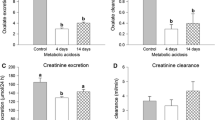Abstract
We studied the effects of an intravenous hydroxypyruvate load on endogenous oxalogenesis in rats receiving a standard diet or a vitamin-B6-deficient diet. Twelve male Wistar rats were randomized to two groups and were fed either a standard diet or a vitamin-B6-deficient diet for 3 weeks. Then the animals received an intravenous infusion of 100 mg/ml (960.6 μmol/ml) of hydroxypyruvate slowly over 10 min. Urine samples were collected just before hydroxypyruvate infusion and at hourly intervals until 5 h afterward. Urinary oxalate, glycolate, and citrate levels were measured by capillary electrophoresis. Hourly urinary oxalate excretion peaked within 2 h, while urinary glycolate excretion peaked at 1 h, after the hydroxypyruvate load in both control and vitamin-B6-deficient rats. Both urinary oxalate and glycolate excretion were higher in vitamin-B6-deficient rats than in control rats. Infusion of hydroxypyruvate increased the 5-h urinary oxalate and glycolate excretion to 0.68% (6.56 μmol) and 0.53% (5.10 μmol) of the administered dose (mol/mol), respectively, in the control rats, while oxalate and glycolate excretion, respectively, increased to 2.43% (23.36 μmol) and 0.79% (7.59 μmol) of the dose in the vitamin-B6-deficient rats. Urinary citrate excretion was significantly lower at baseline and all other times in the vitamin-B6-deficient rats than in the control rats. In conclusion, a hydroxypyruvate load increased endogenous oxalate synthesis in control rats, and its synthesis was even greater in vitamin-B6-deficient rats. Vitamin B6 deficiency also resulted in significant hypocitraturia.



Similar content being viewed by others
References
Ogawa Y, Miyazato T, Hatano T (2000) Oxalate and urinary stones. World J Surg 24:1154–1159
Ogawa Y, Yonou H, Hokama S, Oda M, Morozumi M, Sugaya K (2003) Urinary saturation and risk factors for calcium oxalate stone disease based on spot and 24-hour urine specimens. Front Biosci 8:a167–176
Lewandowski S, Rodgers AL (2004) Idiopathic calcium oxalate urolithiasis: risk factors and conservative treatment. Clin Chim Acta 345:17–34
Holmes RP, Assimos DG (2004) The impact of dietary oxalate on kidney stone formation. Urol Res 32:311–316
Williams HE, Wanzilak TR (1989) Oxalate synthesis, transport and the hyperoxaluric syndromes. J Urol 141:742–749
Holmes RP, Assimos DG (1998) Glyoxylate synthesis and its modulation and influence on oxalate synthesis. J Urol 160:1617–1624
Milliner D, Eickholt J, Bergstralh E, Wilson D, Smith L (1994) Results of long-term treatment with orthophosphate and pyridoxine in patients with primary hyperoxaluria. N Engl J Med 331:1553–1558
Kaelin A, Casez JP, Jaeger P (2004) Vitamin B6 metabolites in idiopathic calcium stone formers: no evidence for a link to hyperoxaluria. Urol Res 32(1):61–68
Nishijima S, Sugaya K, Morozumi M, Hatano T, Ogawa Y (2003) Hepatic alanine-glyoxylate aminotransferase activity and oxalate metabolism in vitamin B6 deficient rats. J Urol 169(2):683–686
Runyan T, Gershoff SN (1965) The effect of vitamin B6 deficiency in rats on the metabolism of oxalic acid precursors. J Biol Chem 240:1889–1892
Holmes RP (1995) Measurement of urinary oxalate and citrate by capillary electrophoresis and indirect ultraviolet absorbance. Clin Chem 41:1297–1301
Ogawa Y, Hatano T (1997) Urinary oxalate and citrate determination. Kidney dialysis Suppl 43:151–157
Ogawa Y, Hossain RZ, Ogawa T, Yamakawa K, Yonou H, Oshiro Y, Hokama S, Morozumi M, Uchida A, Sugaya K (2007) Vitamin B6 deficiency augments endogenous oxalogenesis after intravenous l-hydroxyproline loading in rats. Urol Res 35(1):15–21
Ogawa Y, Miyazato T, Hatano T (1999) Importance of oxalate precursors for oxalate metabolism in rats. J Am Soc Nephrol 10: S341–344
Pak CY (1994) Citrate and renal calculi: an update. Miner Electrolyte Metab 20:371–377
Hallson PC, Rose GA, Sulaiman S (1983) Raising urinary citrate lowers calcium oxalate and calcium phosphate crystal formation in whole urine. Urol Int 28:179–181
Nicar MJ, Hill K, Pak CYC (1987) Inhibition by citrate of spontaneous precipitation of calcium oxalate in vivo. J Bone Miner Res 2:215–220
Schwille PO, Schmiedl A, Hermann U, Fan J, Gottlieb D, Manoharan M, Wipplinger J (1999) Magnesium, citrate and magnesium-alkali citrate as modulators of calcium oxalate crystallization in urine: observations in patients with recurrent idiopathic calcium urolithiasis. Urol Res 27:117–126
Ryall RL, Harnett RM, Marshall VR (1981) The effect of urine, pyrophosphate, citrate, magnesium and glycosaminoglycans on the growth and aggregation of calcium oxalate crystals in vitro. Clin Chim Acta 112:349–356
Bek-Jensen H, Fornander AM, Nilsson MA, Tiselius HG (1996) Is citrate an inhibitor of calcium oxalate crystal growth in high concentration of urine? Urol Res 24:67–71
Tiselius HG, Fornander AM, Nilsson MA (1993) The effects of citrate and urine on calcium oxalate crystal aggregation. Urol Res 21:363–366
Laube N, Jansen B, Hesse A (2002) Citric acid or citrates in urine: which should we focus on in the prevention of calcium oxalate crystals and stones? Urol Res 30:336–341
Murray RK, Granner DK, Mayes PA, Rodwell VW (1996) Chemical constituents of blood and body fluids. In: Harper’s Biochemistry, 24th edn. Appleton and Lange, Stamford, pp 829–34
Ogawa Y, Yamaguchi K, Tanaka T, Morozumi M (1986) Effects of pyruvate salts, pyruvic acid, and bicarbonate salts in preventing experimental oxalate urolithiasis in rats. J Urol 135(5):1057–1060
Chow FH, Hamar DW, Boulay JP, Lewis LD (1978) Prevention of oxalate urolithiasis by some compounds. Invest Urol 15(6):493–495
Scheid CR, Koul K, Hill WA et al (1996) Oxalate ion and calcium oxalate crystal interactions with renal epithelial cells. In: Coe FL, Favus MJ, Pak CYC, Parks JH, Preminger GM (eds) Kidney stone: medial and surgical management. Lippincott-Raven, Philadelphia, pp 129–143
McKechnie R (1983) Oat products in bakery foods. Cereal Foods World 28(10):635–637
Leklem JE (1999) Vitamin B6. In: Shils ME, Olson JA, Shike M, Ross AC (eds) Modern nutrition in health and disease, 9th edn.. Williams Wilkins, Baltimore, pp 413–421
Author information
Authors and Affiliations
Corresponding author
Rights and permissions
About this article
Cite this article
Teerajetgul, Y., Hossain, R.Z., Yamakawa, K. et al. Oxalate synthesis from hydroxypyruvate in vitamin-B6-deficient rats. Urol Res 35, 173–178 (2007). https://doi.org/10.1007/s00240-007-0102-8
Received:
Accepted:
Published:
Issue Date:
DOI: https://doi.org/10.1007/s00240-007-0102-8




